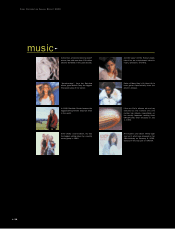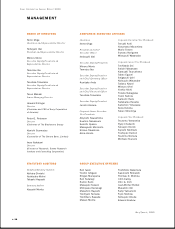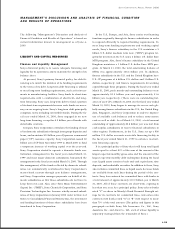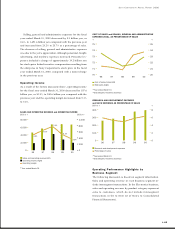Sony 2000 Annual Report Download - page 39
Download and view the complete annual report
Please find page 39 of the 2000 Sony annual report below. You can navigate through the pages in the report by either clicking on the pages listed below, or by using the keyword search tool below to find specific information within the annual report.
SONY CORPORATION ANNUAL REPORT 2000
37
Sony’s Environmental Report 1999 and environmen-
tal reports of other bases.
printed wiring boards contain no halogenated flame retardant, standby power consumption is 0.1
watts, and the packaging cushion for the TV consists of a pulp-mold material made of recycled paper
rather than styrene foam, an industry first for a CRT TV sold in Japan.
Regarding product recycling, the Environmental Center Europe in Germany and the Home Network
Company (HNC) Recycling Research Center in Japan are working on new technologies. Currently, all
Sony CRT plants worldwide recycle scrap CRT glass from the manufacturing process. In Japan, Sony is
taking actions to prepare facilities for recycling necessary to comply with the Law for Recycling Speci-
fied Kinds of Home Appliances (Recycling Law) that will take effect in April 2001.
ENVIRONMENTAL TECHNOLOGIES
During the year under review, Sony developed a plastic identification system capable both of iden-
tifying black-colored plastic materials, a task that had baffled conventional methods, and of detecting
flame retardants contained in plastics. Making this possible is mid-infrared reflectance spectroscopy
and specialized software developed by Sony. Using these technologies, black plastics and flame
retardants can be identified with an accuracy of over 99%. This technology also enables plastics to be
reused as they are, thus being a potential form of “material recycling”, and is attracting attention as a
way to reuse plastics in home electronics and other products. This system was first developed at the
Environmental Center Europe, and now it is undergoing verification aimed at its practical use at the
HNC Recycling Research Center.
PROMOTING EMPLOYEES’ ENVIRONMENTAL EDUCATION AND FULL PARTICIPATION
Based on the philosophy that all employees should be involved in environmental activities, Sony is
aiming to provide employees with environmental education that turns awareness into action. Each
member company of the global Sony Group strives to be a leader in its home region by continuously
participating in environmental programs. Sony Magnetic Products (Thailand) Co. Ltd. (SMPT) is a
prime example. Efforts to produce alkaline batteries in an environmentally responsible manner earned
it the first Green Label status in Thailand for alkaline batteries. This company is also active in community
programs such as planting mangrove trees. These actions are the result of SMPT’s integrating its
environmental management system into company-wide activities. In recognition of its environmental
efforts, in 1998 SMPT won the Thai Prime Minister’s Award for Outstanding Industries, and during the
year under review, SMPT received an Environmental Award from the Pacific Basin Economic Council.
DISCLOSURE OF ENVIRONMENTAL INFORMATION
Sony discloses its environmental record in line with its strong belief that companies have an
accountability to explain their environmental activities to the public. During the year, Sony’s Environ-
mental Report 1999 won Japan’s Director-general of Environment Agency Minister Prize, the top
prize for the Environmental Report Awards supported by
Japan’s Environment Agency. Sony’s previous report
received this same honor. Sony’s manufacturing and non-
manufacturing bases also produce their own environmen-
tal reports to disclose information to their home regions.
During the year, Sony Motomiya Corporation, located in
Fukushima prefecture in Japan, received the Excellence
Prize for its report in the same competition. During the
year, Sony opened the Sony Eco Plaza exhibition space at
its head office to show employees and the general public
the results of selected environmental initiatives.
























